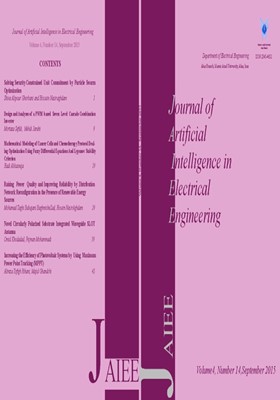Increasing the Efficiency of Photovoltaic Systems by Using Maximum Power Point Tracking (MPPT)
محورهای موضوعی : journal of Artificial Intelligence in Electrical Engineering
Alireza Tofigh Rihani
1
,
Majid Ghandchi
2
![]()
1 -
2 -
کلید واژه: MPPT, Renewable Energy, photovoltaic cell, production power,
چکیده مقاله :
Using Photovoltaic systems is gradually expanded by increasing energy demand. Abundance and availability of this energy, has turned to one of the most important sources of renewable energy. Unfortunately, photovoltaic systems have two big problems: first, those have very low energy conversion efficiency (in act between 12 and 42 percent under certain circumstances). Second, the power produced by the solar cell depends on nonlinear conditions such as solar radiation, temperature and charge feature. According to this, received power maximum of photovoltaic cells depends on different non-linear variables, it is necessary to be continuously traced, as maximum received power of the cell (by controller). In this research, the increasing efficiency of photovoltaic systems has been investigated by using Maximum Power Point Tracking (MPPT) in two different modes contained connected to the Grid and disconnected from the grid with simulation by MATLAB software. The obtained results showed that the proposed technique is able to improve the current, voltage and power output of photovoltaic cells.
[1] Mohamed M. Algazara & Hamdy Almonierb &
Hamdy Abd EL-halima & Mohamed Ezzat El
Kotb Salem (2012). Maximum power point
tracking using fuzzy logic control. Electrical
Power and Energy Systems, Vol. 39, pp. 21-28.
[2] I.H. Altasa & A.M. Sharaf (2008). A novel
maximum power fuzzy logic controller for
photovoltaic solar energy systems", Renewable
Energy, Vol. 33, pp. 388–399.
[3] Naseer Ahmad, Anwar K. Sheikh, P. Gandhidasan, Moustafa Elshafie (2015). Modeling, simulation and performance evaluation of a community scale PVRO water desalination system operated by fixed and tracking PV panels: A case study for Dhahran city, Saudi Arabia. Renewable Energy, Volume 75, Pages 433-447.
[4] Rakibuzzaman Shah, N. Mithulananthan, R.C.
Bansal, V.K. Ramachandaramurthy (2015). A
review of key power system stability challenges
for large-scale PV integration. Renewable and
Sustainable Energy Reviews, Volume 41, January
2015, Pages 1423-1436.
[5] K. Sundareswaran, V. Vigneshkumar, S. Palani
(2015). Application of a combined particle swarm
optimization and perturb and observe method for
MPPT in PV systems under partial shading
conditions. Renewable Energy, Volume 75, Pages
308-317.
[6] Jorge Esteban Tobón, Juan M. Ramirez, Rosa E.
Correa Gutierrez (2015). Tracking the maximum
power transfer and loadability limit from
sensitivities-based impedance matching. Electric
Power Systems Research, Volume 119, Pages
355-363.
[7] GO OKADA, Katsuya, Shigeyasu (2006).
DEVELOPMENT OF A HIGH – SPEED
SYSTEM MEASURING A MAXIMUM POWER
OF PV MODULES. IEEE photovoltaic Energy
conversion conference; 5:2262-2263.
[8] ChihchiangHua, jongrong Lin (2004). A modified tracking algorithm for maximum power tracking of solar array. .ELSEVIER Energy conversion and Management:911-925
[9] Chen-chi chu , chieh –Li chen (2009). Robust maximum power point tracking method for photovoltaic cell: A sliding control approach. ,ELSEVIER Solar Energy,83 2009:1370-1378
[10] Jancarle L. Santos , Fernando Antunes , AnisChehab , Cicere Cruz (2006). A maximum power point tracker for PV systems using a high performance boost converter. ELSEVIER Solar Energy:772-778
[11] V.Salas , E .Olias , A.Lazaro , A.Barrado (2005). New algorithm only one variable measurement applied to a maximum power point tracker. ELSEVIER Solar Energy Materials & solar cell:675-684
[12] B.J. Huang & W.L. Ding & Y.C. Huang (2011).
Long-term field test of solar PV power
generation using one-axis3-position sun tracker.
Solar Energy , Vol. 85, 1935–1944.
[13] L. Piegari& R. Rizzo (2010). Adaptive perturb
and observe algorithm for photovoltaic maximum
power point tracking" IET Renew.Power Gener,
Vol. 4, pp. 317–328.
[14] N. Femia, D. Granozio, G. Petrone, G. Spagnuolo, & M. Vitelli (2005). Optimization of perturb and observe maximum power point tracking method. IEEE Trans. Power Electron.
[15] Vladimir V. R. Scarpa& Simone Buso& Giorgio Spiazzi (2009). Low-Complexity MPPT Technique Exploiting the PV Module MPP Locus Characterization. IEEE transactions on industrial electronics, Vol. 56, pp. 1531- 1538.
[16] Dondi D & Bertacchini A & Brunelli D & Larcher L & Benini L (2008). Modeling and optimization of a solar energy harvester system for self-powered wireless sensor networks. IEEE Transactions on Industrial Electronics, Vol. 55, pp. 2759–2766.
[17] S. Yuvarajan & S. Xu (2003). Photo-voltaic power converter with a simple maximumpower- point-tracker. in Proc. 2003 Int. Symp.Circuits Syst., pp. 399–402.
[18] Mohamed M. Algazara & Hamdy Almonierb &
Hamdy Abd EL-halima & Mohamed Ezzat El
Kotb Salem (2012). Maximum power point
tracking using fuzzy logic control. Electrical
Power and Energy Systems, Vol. 39, pp. 21-28.


